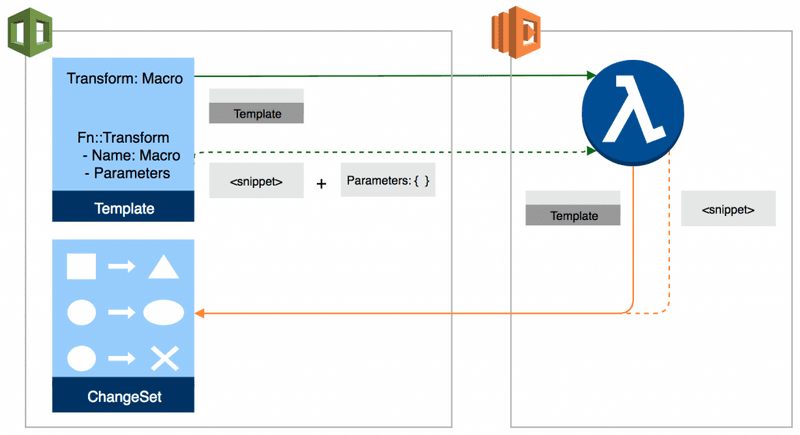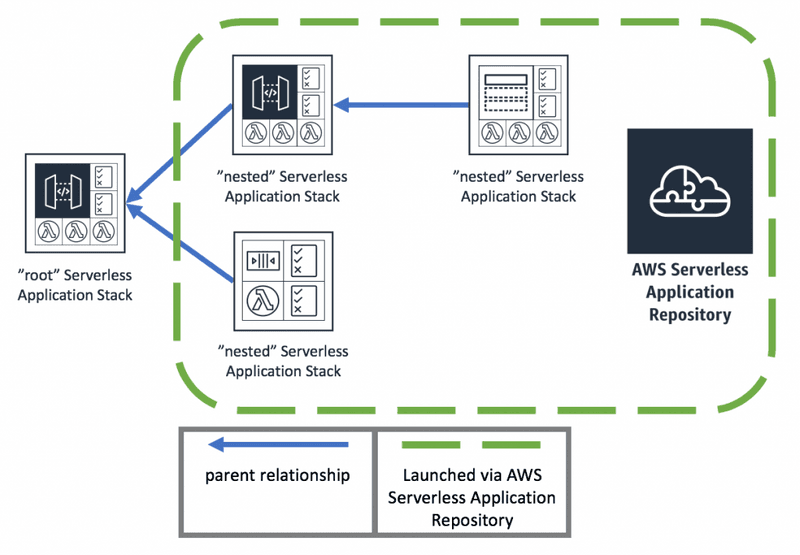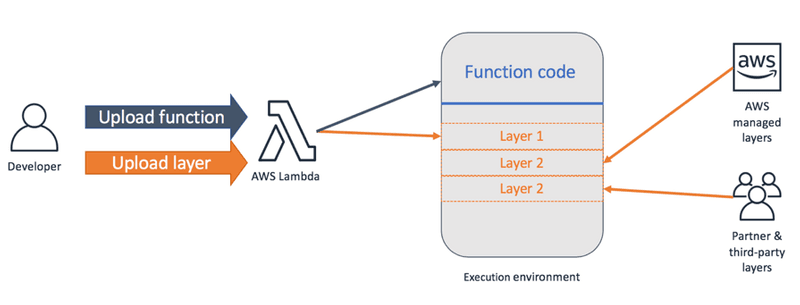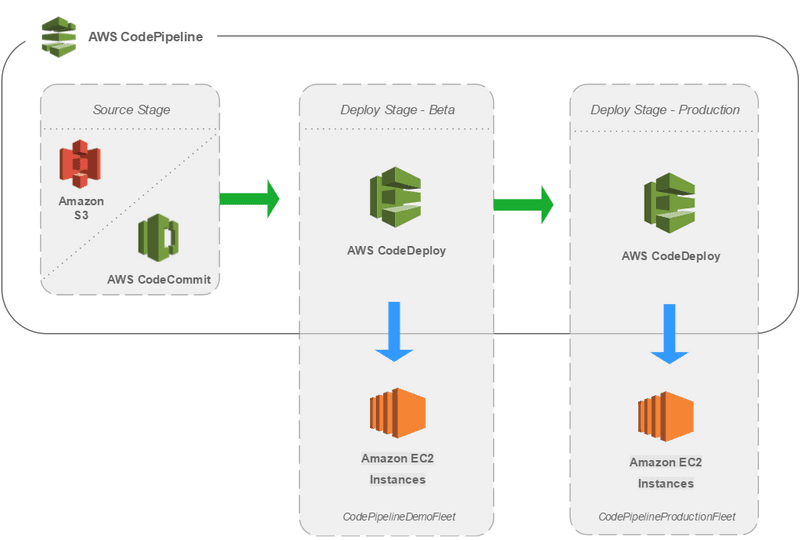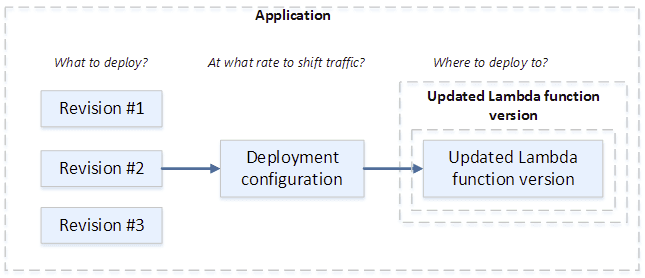AWS Deployment - Exam Notes
AWS Certified Developer
Table of Contents
Elastic BeanStalk
In ElasticBeanstalk, you can choose from a variety of deployment methods:
- All at once– Deploy the new version to all instances simultaneously. All instances in your environment are out of service for a short time while the deployment occurs.
- Rolling– Deploy the new version in batches. Each batch is taken out of service during the deployment phase, reducing your environment’s capacity by the number of instances in a batch.
- Rolling with additional batch– Deploy the new version in batches, but first launch a new batch of instances to ensure full capacity during the deployment process.
- Immutable– Deploy the new version to a fresh group of instances by performing animmutable update.
- Blue/Green– Deploy the new version to a separate environment, and then swap CNAMEs of the two environments to redirect traffic to the new version instantly.
o maintain full capacity during deployments, you can configure your environment to launch a new batch of instances before taking any instances out of service. This option is known as arolling deployment with an additional batch. When the deployment completes, Elastic Beanstalk terminates the additional batch of instances. Immutable environment updates are an alternative torolling updates. Immutable environment updates ensure that configuration changes that require replacing instances are applied efficiently and safely. If an immutable environment update fails, the rollback process requires only terminating an Auto Scaling group. A failed rolling update, on the other hand, requires performing an additional rolling update to roll back the changes. To perform an immutable environment update, Elastic Beanstalk creates a second, temporary Auto Scaling group behind your environment’s load balancer to contain the new instances. First, Elastic Beanstalk launches a single instance with the new configuration in the new group. This instance serves traffic alongside all of the instances in the original Auto Scaling group that are running the previous configuration.
Platform Updates
Elastic Beanstalk regularly releases new platform versions to update all Linux-based and Windows Server-basedplatforms. New platform versions provide updates to existing software components and support for new features and configuration options. You can use the Elastic Beanstalk console or the EB CLI to update your environment’s platform version. Depending on the platform version you’d like to update to, Elastic Beanstalk recommends one of two methods for performing platform updates.
- Method 1 – Update your Environment’s Platform Version– This is the recommended method when you’re updating to the latest platform version, without a change in runtime, web server, or application server versions, and without a change in the major platform version. This is the most common and routine platform update.
- Method 2 – Perform a Blue/Green Deployment– This is the recommended method when you’re updating to a different runtime, web server, or application server versions, or to a different major platform version. This is a good approach when you want to take advantage of new runtime capabilities or the latest Elastic Beanstalk functionality.
Because AWS Elastic Beanstalk performs an in-place update when you update your application versions, your application can become unavailable to users for a short period of time. You can avoid this downtime by performing a blue/green deployment, where you deploy the new version to a separate environment, and then swap CNAMEs of the two environments to redirect traffic to the new version instantly. Blue/green deployments require that your environment runs independently of your production database, if your application uses one. If your environment has an Amazon RDS DB instance attached to it, the data will not transfer over to your second environment, and will be lost if you terminate the original environment.
CloudFormation
AWS CloudFormation is a service that helps you model and set up your Amazon Web Services resources so that you can spend less time managing those resources and more time focusing on your applications that run in AWS. You create a template that describes all the AWS resources that you want, and AWS CloudFormation takes care of provisioning and configuring those resources for you. A Cloudformation template is a JSON- or YAML-formatted text file that describes your AWS infrastructure. The template includes several sections for you to define your infrastructure code.
For serverless applications(also referred to as Lambda-based applications), the Transform section specifies the version of theAWS Serverless Application Model (AWS SAM)to use. When you specify a transform, you can use AWS SAM syntax to declare resources in your template. The model defines the syntax that you can use and how it is processed. More specifically, theAWS::Serverlesstransform, which is a macro hosted by AWS CloudFormation, takes an entire template written in the AWS Serverless Application Model (AWS SAM) syntax and transforms and expands it into a compliant AWS CloudFormation template.
AWS CloudFormation provides the following Python helper scripts that you can use to install software and start services on an Amazon EC2 instance that you create as part of your stack:
- cfn-init: Use to retrieve and interpret resource metadata, install packages, create files, and start services.
- cfn-signal: Use to signal with a CreationPolicy or WaitCondition, so you can synchronize other resources in the stack when the prerequisite resource or application is ready.
- cfn-get-metadata: Use to retrieve metadata for a resource or path to a specific key.
- cfn-hup: Use to check for updates to metadata and execute custom hooks when changes are detected.
You call the scripts directly from your template. The scripts work in conjunction with resource metadata that’s defined in the same template. The scripts run on the Amazon EC2 instance during the stack creation process. The scripts are not executed by default. You must include calls in your template to execute specific helper scripts.
StackSets
AWS CloudFormation StackSets extends the functionality of stacks by enabling you to create, update, or delete stacks across multiple accounts and regions with a single operation. Using an administrator account, you define and manage an AWS CloudFormation template, and use the template as the basis for provisioning stacks into selected target accounts across specified regions.
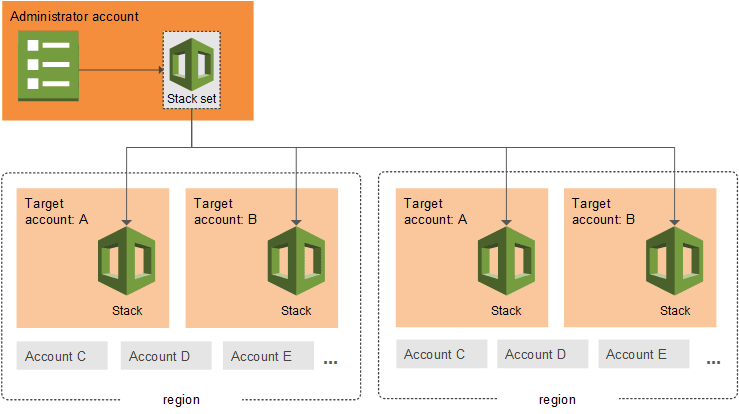
Astack setlets you create stacks in AWS accounts across regions by using a single AWS CloudFormation template. All the resources included in each stack are defined by the stack set’s AWS CloudFormation template. As you create the stack set, you specify the template to use, as well as any parameters and capabilities that the template requires.
SAM
The AWS Serverless Application Model (AWS SAM) is an open-source framework that you can use to build serverless applications on AWS. It consists of the AWS SAM template specification that you use to define your serverless applications, and the AWS SAM command line interface (AWS SAM CLI) that you use to build, test, and deploy your serverless applications.
Because AWS SAM is an extension of AWS CloudFormation, you get the reliable deployment capabilities of AWS CloudFormation. You can define resources by using AWS CloudFormation in your AWS SAM template. Also, you can use the full suite of resources, intrinsic functions, and other template features that are available in AWS CloudFormation. You can use AWS SAM with a suite of AWS tools for building serverless applications. The AWS SAM CLI lets you locally build, test, and debug serverless applications that are defined by AWS SAM templates. The CLI provides a Lambda-like execution environment locally. It helps you catch issues upfront by providing parity with the actual Lambda execution environment. To step through and debug your code to understand what the code is doing, you can use AWS SAM with AWS toolkits like the AWS Toolkit for JetBrains, AWS Toolkit for PyCharm, AWS Toolkit for IntelliJ, and AWS Toolkit for Visual Studio Code. This tightens the feedback loop by making it possible for you to find and troubleshoot issues that you might run into in the cloud.
AWS SAM uses AWS CloudFormation as the underlying deployment mechanism.You can deploy your application by using AWS SAM command line interface (CLI) commands. You can also use other AWS services that integrate with AWS SAM to automate your deployments. After you develop and test your serverless application locally, you can deploy your application by using thesam packageandsam deploy commands.
Take note that both thesam packageandsam deploycommands are identical to their AWS CLI equivalent commands which areaws cloudformation packageandaws cloudformation deploy, respectively. Thesam packagecommand zips your code artifacts, uploads them to Amazon S3, and produces a packaged AWS SAM template file that’s ready to be used. Thesam deploycommand uses this file to deploy your application. To deploy an application that contains one or more nested applications, you must include theCAPABILITYAUTOEXPANDcapability in thesam deploycommand.
Lambda
To create a Lambda function you first create a Lambda function deployment package, a .zip or .jar file consisting of your code and any dependencies. When creating the zip, include only the code and its dependencies, not the containing folder. You will then need to set the appropriate security permissions for the zip package. If you are using a CloudFormation template, you can configure the AWS::Lambda::Function resource which creates a Lambda function. To create a function, you need a deployment package and an execution role. The deployment package contains your function code. The execution role grants the function permission to use AWS services, such as Amazon CloudWatch Logs for log streaming and AWS X-Ray for request tracing.
Under the AWS::Lambda::Function resource, you can use the Code property which contains the deployment package for a Lambda function. For all runtimes, you can specify the location of an object in Amazon S3. For Node.js and Python functions, you can specify the function code inline in the template. Changes to a deployment package in Amazon S3 are not detected automatically during stack updates. To update the function code, change the object key or version in the template.
Layers
You can configure your Lambda function to pull in additional code and content in the form of layers. A layer is a ZIP archive that contains libraries, acustom runtime, or other dependencies. With layers, you can use libraries in your function without needing to include them in your deployment package. Layers let you keep your deployment package small, which makes development easier. You can avoid errors that can occur when you install and package dependencies with your function code. For Node.js, Python, and Ruby functions, you candevelop your function code in the Lambda consoleas long as you keep your deployment package under 3 MB.
A function can use up to 5 layers at a time. The total unzipped size of the function and all layers can’t exceed the unzipped deployment package size limit of 250 MB. You can create layers, or use layers published by AWS and other AWS customers. Layers support resource-based policies for granting layer usage permissions to specific AWS accounts, AWS Organizations, or all accounts. Layers are extracted to the /opt directory in the function execution environment. Each runtime looks for libraries in a different location under /opt, depending on the language. Structure your layer so that function code can access libraries without additional configuration.
CodeDeploy
CodeDeploy is a deployment service that automates application deployments to Amazon EC2 instances, on-premises instances, serverless Lambda functions, or Amazon ECS services. CodeBuild eliminates the need to provision, manage, and scale your own build servers
benefits:
- Fully managed – CodeBuild eliminates the need to set up, patch, update, and manage your own build servers.
- On demand – CodeBuild scales on demand to meet your build needs. You pay only for the number of build minutes you consume.
- Out of the box – CodeBuild provides preconfigured build environments for the most popular programming languages. All you need to do is point to your build script to start your first build.
CodeDeploy can deploy application content that runs on a server and is stored in Amazon S3 buckets, GitHub repositories, or Bitbucket repositories. CodeDeploy can also deploy a serverless Lambda function. You do not need to make changes to your existing code before you can use CodeDeploy.
CodeDeploy provides two deployment type options:
-
In-place deployment: The application on each instance in the deployment group is stopped, the latest application revision is installed, and the new version of the application is started and validated. You can use a load balancer so that each instance is deregistered during its deployment and then restored to service after the deployment is complete. Only deployments that use the EC2/On-Premises compute platform can use in-place deployments. AWS Lambda compute platform deployments cannot use an in-place deployment type.
-
Blue/green deployment: The behavior of your deployment depends on which compute platform you use:
- Blue/green on an EC2/On-Premises compute platform: The instances in a deployment group (the original environment) are replaced by a different set of instances (the replacement environment). If you use an EC2/On-Premises compute platform, be aware that blue/green deployments work with Amazon EC2 instances only.
- Blue/green on an AWS Lambda compute platform: Traffic is shifted from your current serverless environment to one with your updated Lambda function versions. You can specify Lambda functions that perform validation tests and choose the way in which the traffic shift occurs. All AWS Lambda compute platform deployments are blue/green deployments. For this reason, you do not need to specify a deployment type.
- Blue/green on an Amazon ECS compute platform: Traffic is shifted from the task set with the original version of a containerized application in an Amazon ECS service to a replacement task set in the same service. The protocol and port of a specified load balancer listener are used to reroute production traffic. During deployment, a test listener can be used to serve traffic to the replacement task set while validation tests are run.
The CodeDeploy agent is a software package that, when installed and configured on an instance, makes it possible for that instance to be used in CodeDeploy deployments. The CodeDeploy agent communicates outbound using HTTPS over port 443. It is also important to note that the CodeDeploy agent is required only if you deploy to an EC2/On-Premises compute platform. The agent is not required for deployments that use the Amazon ECS or AWS Lambda compute platform.
CodeDeploy can also deploy a serverless Lambda function. You do not need to make changes to your existing code before you can use CodeDeploy. When you deploy to an AWS Lambda compute platform, the deployment configuration specifies the way traffic is shifted to the new Lambda function versions in your application.
In a Canary deployment configuration, the traffic is shifted in two increments. You can choose from predefined canary options that specify the percentage of traffic shifted to your updated Lambda function version in the first increment and the interval, in minutes, before the remaining traffic is shifted in the second increment.

